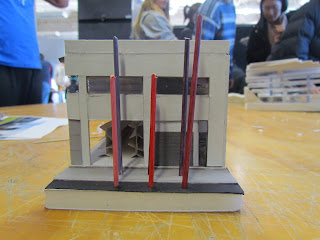The final week or more half-week to finish the laser cutting workshop.
The 'Crit' on monday seemed to go ok, but I wasn't focusing on the architectural purpose of it all, more the aesthetic. I needed a motive, more of a purpose than to look good, the idea of the different heightened roofs/walls played a big part in this, they allowed different amounts of light to enter the modular rooms, creating different moods/feelings for the different paintings in the rooms.
there was also a fine line between been inside the 'art gallery' and been outside to the park and roads, which was suggested by Roberta that it needed to be more distinct and apparent, and working with this idea as-well as the use of light. She suggested I look at a very famous artist 'Piet Mondrian' Who made a step towards abstractness, which I embarrassingly couldn't recall until I looked at some of his works at the Elam library. My concepts were similar to that of Mondrians, and I new what the tutors were getting at as soon as I looked at his (later-as opposed to earlier) paintings.
Piet Mondrian, Tableau 2, 1922.
Piet Mondrian "Composition With Yellow, Red, Black, Blue, and Grey"
Above are some of his later paintings from a natural, realistic and refined/distilled contoured planes of not only trees but cities. They were very similar to my previous drawings of aerial view, and with some research I put some of his ideas to mine own work, mixing them with the idea of light entering the building to form different moods for the somewhat simple rooms
Monday night was a very busy time, developing the design into a final, and then drawing it to scale, above shows the first attempt to a 1:20 scale drawing of the plan
I worked on some more drawings, mainly in plan and elevation views. I had come to an 'answer' for the market stall, with an artistic based structural design, and a familiar art gallery feeling to it, focusing on the light that floods into the different openings and slits that are between each roof space and height, it did look bizarre in a way, but thats what attracts people to it...a different, unique building space for the public to enjoy what i've created in my own time.
The near final 1:50 drawing, darker/thicker lines indicating the walls under the roofs, which led to the much larger 1:20 plan
Working out heights and how people may compare in size to the surrounding walls/roofs
The final design on paper, full sized 1:20, with many measurements written down in the process, its off this A3 page that I created the file on illustrator, referring back and fourth to the dimensions
Close up of the centre walls, where much of the light floods through, at 3.25m's (3250mm)
Measurements in the centre represent the height, I had to work out the real measurements from the 1:20 to 1:1, apparently there was a way to make it scaled on illustrator but I decided to go for the real measurements
I spent much of monday night drawing it up to scale (as shown above), then much of tuesday making it on the computer, making sure each joint, height and width is perfect to fit...without making a mock up model it was hard to tell if it was in fact going to fit together perfectly, but I just had to wait and see and hope for the best. Due to the uni laser cutter been moved it was getting busy and it was not possible to hand it in in the mid afternoon, so a group of us now have to find a new place (as its out of action for a week or so). Yes we took extra long to make the final computer models, but the fact they decide to move it during the end of semester (with two weeks left till the holidays) we were annoyed to find that they didn't just wait till then, but no, they decide to move it when people need it most.
So we are heading over to a place at the top of queen street, and hopefully they will be able to help us, otherwise its AUT, and apparently they are a bit grumpy...how surprising. I should have worked out my final model earlier, but when it still needs change on monday I find it a bit difficult to accomplish this quickly, but I will have to learn to adapt to it...



















































